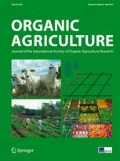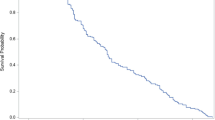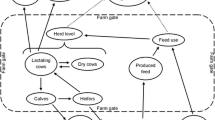Abstract
Over the past few decades, the main focus in dairy cow breeding in Europe and North America has been on maximising milk yield per lactation, but more and more, dairy farmers are faced with severe declines in fitness traits and therefore reduced longevity. This is not only questionable from a sustainability perspective but also from an economic point of view. The aim of this study was to highlight the economic importance of longevity in organic dairy cattle husbandry. To this end, performance and reproductive data of 44,976 Austrian organic Simmental dairy cows were grouped according to longevity and milk yield and analysed by applying a bio-economic model. Profit per year was calculated using full cost accounting. Two farm scenarios were modelled and assessed: limited milk quota and limited stocking rate, as well as different market situations (abolition of milk quota and varying concentrate and milk prices). Cows reached maximum annual milk yield in the 5th lactation. Overall costs declined with increasing longevity due to dropping replacement costs. Annual profit was influenced considerably by milk yield and longevity. It reached its peak in the 6th lactation. Short-lived animals needed substantially higher annual milk yields than long-lived animals to achieve equal annual profits. The market scenarios applied showed an increasing importance of longevity in situations of increasing economic pressure (+20 % of concentrate and −20 % of milk price). It has been clearly proven that extending longevity allows lower milk yield levels without decreasing profitability. Considerable lower use of concentrates and reduced dependence on off-farm inputs and market fluctuations are further benefits.





Similar content being viewed by others
References
Adin G, Solomon R, Nikbachat M, Zenou A, Yosef E, Brosh A, Shabtay A, Mabjeesh SJ, Halachmi I, Miron J (2009) Effect of feeding cows in early lactation with diets differing roughage-neutral detergent fiber content on intake behavior, rumination and milk production. J Dairy Sci 92:3364–3373
AMA (2007) ÖPUL–Biologische Wirtschaftsweise. Available from http://www.ama.at/Portal.Node/ama/public?gentics.rm=PCP&gentics.pm=gti_full&p.contentid=10008.47296&MEBBIO.pdf. Accessed 5 April 2010
AMA (2011a) Erzeugermilchpreiserhebung Österreich ab Hof–Jänner bis Dezember 2010. Available from http://www.ama.at/Portal.Node/ama/public?gentics.rm=PCP&gentics.pm=gti_full&p.contentid=10008.76026&079_Milchpreis_10_AT.pdf. Accessed 09 March 2011
AMA (2011b) Das Informationsportal der Agrarmarkt Austria. Available from http://www.ama.at/Portal.Node/ama/public?gentics.am=PCP&p.contentid=10007.19206. Accessed 15 November 2011
Aziz O, Kaufmann O, Hasselmann L (2009) Relationship between feeding behaviour and feed intake of dairy cows depending on their parity and milk yield. Livest Sci 122:156–161
BMLFUW (2006a) Der Biomilchmarkt in Österreich und Europa-Entwicklungen und wirtschaftliche Perspektiven. Bundesministerium für Land- und Forstwirtschaft, Umwelt und Wasserwirtschaft, Wien
BMLFUW (2006b) Richtlinien für die sachgerechte Düngung. Bundesministerium für Land- und Forstwirtschaft, Umwelt und Wasserwirtschaft, Wien
BMLFUW (2008) Deckungsbeiträge und Daten für die Betriebsplanung 2008. Bundesministerium für Land- und Forstwirtschaft, Umwelt und Wasserwirtschaft, Wien
BMLFUW (2010) Milchproduktion 2009–Ergebnisse und Konsequenzen der Betriebszweigauswertung aus den Arbeitskreisen in Österreich. Bundesministerium für Land- und Forstwirtschaft, Umwelt und Wasserwirtschaft, Wien
BMLFUW (2011) Grüner Bericht 2011–Bericht über die Situation der österreichischen Land- und Forstwirtschaft. Bundesministerium für Land- und Forstwirtschaft, Umwelt und Wasserwirtschaft, Wien
Coffey MP, Simm G, Oldham JD, Hill WG, Brotherstone S (2004) Genotype and diet effects on energy balance in the first three lactations of dairy cows. J Dairy Sci 87:4318–4326
Commission of the European Communities (2008) Commission Regulation (EC) No. 889/2008 of 5 September 2008 laying down detailed rules for the implementation of Council Regulation (EC) No 834/2007 on organic production and labelling of organic products with regard to organic production, labelling and control. Available from http://eur-lex.europa.eu/LexUriServ/LexUriServ.do?uri=OJ:L:2008:250:0001:01:EN:HTML. Accessed 02 March 2011
Congleton WR, King LW (1984) Profitability of dairy cow herd life. J Dairy Sci 67:661–674
Dillon P, Snijders S, Buckley F, Harris B, O’Connor P, Mee JF (2003) A comparison of different dairy cow breeds on a seasonal grass-based system of milk production—2. Reproduction and survival. Livest Prod Sci 83:35–42
Distl O (1995) Tierarztkosten in bayrinschen Fleckviehbetrieben. Cited from Miesenberger, J. (1997) Zuchtzieldefinition und Indexselektion für die österreichische Rinderzucht. Dissertation, Universität für Bodenkultur Wien
Essl A (1998) Longevity in dairy cattle breeding: a review. Livest Prod Sci 57:79–89
Evans RD, Wallace M, Shalloo L, Garrick DJ, Dillon P (2006) Financial implications of recent declines in reproduction and survival of Holstein–Friesian cows in spring-calving Irish dairy herds. Agric Syst 89:165–183
Faverdin P, Dulphy JP, Coulon JB, Verite R, Garel JP, Rouel J, Marquis B (1991) Substitution of roughage by concentrates for dairy cows. Livest Prod Sci 27:137–156
Fleischer P, Metzner M, Beyerbach M, Hoedemaker M, Klee W (2001) The relationship between milk yield and the incidence of some diseases in dairy cows. J Dairy Sci 84:2025–2035
GfE (2001) Empfehlungen zur Energie- und Nährstoffversorgung der Milchkühe und Aufzuchtrinder. Ausschuss für Bedarfsnormen der Gesellschaft für Ernährungsphysiologie, DLG-Verlag, Frankfurt am Main
Greimel M (2000) Wirtschaftlichkeit der Milcherzeugung am biologisch wirtschaftenden Betrieb. 27. Viehwirtschaftliche Fachtagung, Bundesanstalt für alpenländische Landwirtschaft Gumpenstein, Irdning
Gröhn YT, Eicker SW, Hertl JA (1995) The associacion between previous 305-day milk yield and disease in New York State dairy cows. J Dairy Sci 78:1693–1702
Gruber L, Steinwender R, und Baumgertner W (1995) Einfluss von Grundfutter-qualität und Kraftfutterniveau auf Leistung, Stoffwechsel und Wirtschaftlichekeit von Kühen der Rasse Fleckvieh und Holstein Friesian. 22. Tierzuchttagung, Bundesanstalt für alpenländische Landwirtschaft Gumpenstein, Irdning
Gruber L, Schwarz F, Erdin D, Fischer B, Spiekers H, Steingass H, Meyer U, Chassot A, Jilg T, Obermaier A and Guggenberger T (2004) Vorhersage der Futteraufnahme von Milchkühen—Kooperation von 10 Universitäts- und Forschungsinstituten Österreichs, Deutschlands und der Schweiz. 31. Viehwirtschaftlichen Fachtagung, Bundesanstalt für alpenländische Landwirtschaft Gumpenstein, Irdning
Haiger A (2005) Naturgemäße Tierzucht bei Rindern und Schweinen. Österreichischer Agrarverlag, Leopoldsdorf
Haiger A and Knaus W (2010) Vergleich von Fleckvieh und Holstein Friesian in der Milch- und Fleischleistung—1. Mitteilung: Milchleistungsvergleich ohne Kraftfutter. Züchtungskunde 82:131–143
Harms J (2007) Betriebswirtschaftliche Betrachtungen der Lebensleistung und Nutzungsdauer von Milchkühen in Mecklenburg–Vorpommern. Landesforschungsanstalt für Landwirtschaft und Fischerei Mecklenburg–Vorpommern
Holmes CW, Brookes IM, Garrick DJ, Mackenzie DDS, Parkinson TJ, Wilson GF (2002) Milk production from pasture. Massey University, Palmerston North
Hufe P (2003) Ansätze zur Senkung der Remontierungsraten in einem Milchviehbetrieb. Zuchtungskunde 75:472–478
IFCN (2011) Dairy report 2011—For a better understanding of milk production world-wide. International Farm Comparison Network, Kiel
Jarrige R (1989) Ruminant nutrition—recommended allowances and feed tables. INRA, Paris
Jaster K (2004) Zum Einfluss der Milchleistung auf die Wirtschaftlichkeit der Milcherzeugung. Zuchtungskunde 76:449–456
Kamphues F, Coenen M, Iben C, Kienzle E, Palluf J, Simon O, Wanner M, Zentek J (2009) Supplemente zu Vorlesungen und Übungen in der Tierernährung. Schaper, Hannover
Knaus W (2009) Dairy cows trapped between performance demands and adaptability. J Sci Food Agr 89:1107–1114, and 1623
LBG (2010) Buchführungsergebnisse 2009 der Land- und Forstwirtschaft Österreichs. LBG Wirtschaftstreuhand und Beratungsgesellschaft m. b. H., Wien
Mack G (1996) Wirtschaftlichkeit des züchterischen Fortschritts in Milchviehherden–Gesamtbetriebliche Analyse mit Hilfe eines simultan–dynamischen linearen Planungsansatzes. Dissertation, Universität Hohenheim
Miesenberger J (1997) Zuchtzieldefinition und Indexselektion für die österreichische Rinderzucht. Dissertation, Universität für Bodenkultur Wien
ÖKL (2010) Richtwerte für Maschinenselbstkosten. Available from http://richtwerte.oekl.at/. Accessed 25 December 2010
Oltenacu PA, Broom DM (2010) The impact of genetic selection for increased milk yield on the welfare of dairy cows. Anim Welfare 19:39–49
Opsomer G, Coryn M, Deluyker H, de Kruif A (1998) An analysis of ovarian dysfunction in high yielding dairy cows based of progesterone profiles. Reprod Dom Anim 33:193–204
Over R (2006) Was bringt eine lange Nutzungsdauer? Landesanstalt für Entwicklung der Landwirtschaft und der ländlichen Räume, Schwäbisch Gmünd
Postler G (2002) Wie erwirtschafte ich mit geringst möglichem Aufwand den höchsten Gewinn in der Milchviehhaltung—Kostenreduktion, Aufwand/Ertrags-Verhältnis. 29. Viehwirtschaftliche Fachtagung, Bundesanstalt für alpenländische Landwirtschaft Gumpenstein, Irdning
Reinsch N, Jaitner J, Dempfle L (1997) Investigations in functional traits inSimmental—2. Incidence of diseases in German Simmental cows. Livest Prod Sci 52:87–96
Roche JF (2006) The effect of nutritional management of the dairy cow on reproductive efficiency. Anim Reprod Sci 96:282–296
Roche JF, MacDonald KA, Burke CR, Lee JM, Berry DP (2007) Associations among body condition score, body weight and reproductive performance in seasonal-calving dairy cattle. J Dairy Sci 90:376–391
Roesch M, Doherr GM, Blum JW (2005) Performance of dairy cows in swiss dairy farms with organic and integrated production. J Dairy Sci 88:2462–2475
Rohde H (2009) Lebensleistung und Nutzungsdauer bei deutschen Holstein Kühen. Dissertation, Tierärztliche Hochschule Hannover
Roibas D, Alvarez A (2010) Impact of genetic progress in the profits of dairy farmers. J Dairy Sci 93:4366–4373
Schierenbeck S, König S, Simianer H (2009) Genetic and environmental impact on auction prices for Holstein cows. Livest Sci 121:327–334
Statistik Austria (2011) Landwirtschaftliche Gesamtrechnung—Produktionskonto. http://www.statistik.at/web_de/statistiken/land_und_forstwirtschaft/gesamtrechnung/landwirtschaftliche_gesamtrechnung/index.html. Accessed 20 March 2011
Steinwidder A, Greimel M (1999) Ökonomische Bewertung der Nutzungsdauer bei Milchkühen. Die Bodenkultur 50:235–249
Steinwidder A, Gruber L (2001) Einfluss der biologischen Wirtschaftsweise auf die Energie und Proteinversorgung von Milchkühen–Modellkalkulationen auf Basis neuer gesetzlicher Normen. Die Bodenkultur 51:71–83
Tamminga S (1996) A review on environmental impacts of nutritional strategies in ruminants. J Anim Sci 74:3112–3124
Tozer PR, Heinrichs AJ (2001) What affects the costs of raising replacement dairy Heifers: a multiple—component analysis. J Dairy Sci 84:1836–1844
VandeHaar MJ, St-Pierre N (2006) Major advances in nutrition: relevance to the sustainability of the dairy industry. J Dairy Sci 89:1280–1291
Wangler A and Harms J (2006) Verlängerung der Nutzungsdauer der Milchkühe durch eine gute Tiergesundheit bei gleichzeitig hoher Lebensleistung zur Erhöhung der Effizienz des Tiereinsatzes. Landesforschungsanstalt für Landwirtschaft und Fischerei Mecklenburg–Vorpommern
Wilson P (2011) Decomposing variation in dairy profitability: the impact of output, inputs, prices, labour and management. J Agr Sci 149:507–517
Wolfová M, Wolf J, Kvapilik J, Kica J (2007) Selection for profit in cattle: I. Economic weights for purebred dairy cattle in the Czech Republic. J Dairy Sci 90:2442–2455
Wurm K, Gsöls F, Heidenbauer G (2007) Ration sofware for dairy cows. Superration Version 6.0
ZAR (1971) Die Österreichische Rinderzucht. Editions 1970. Zentrale Arbeitsgemeinschaft österreichischer Rinderzüchter, Wien
ZAR (2010) Performance and reproductive data of Austrian organic dual-purpose Simmental dairy cows culled between 2000 and 2010 (those were internal, not published data of the Association of Austrian Cattle Breeders)
ZAR (2011) Die Österreichische Rinderzucht. Editions 2010. Zentrale Arbeitsgemeinschaft österreichischer Rinderzüchter, Wien
Zuchtdata (2010) Jahresbericht Zuchtdata. Zuchtdata EDV Dienstleistungen GmbH., Wien
Acknowledgements
The authors would like to thank the Association of Austrian Cattle Breeders for providing the dataset as well as Kathleen Knaus for editing assistance.
Author information
Authors and Affiliations
Corresponding author
Rights and permissions
About this article
Cite this article
Horn, M., Knaus, W., Kirner, L. et al. Economic evaluation of longevity in organic dairy cows. Org. Agr. 2, 127–143 (2012). https://doi.org/10.1007/s13165-012-0027-6
Received:
Accepted:
Published:
Issue Date:
DOI: https://doi.org/10.1007/s13165-012-0027-6




